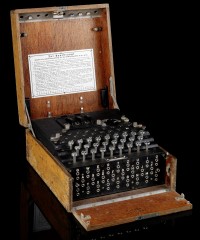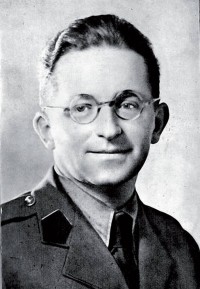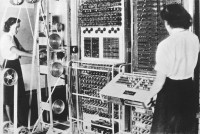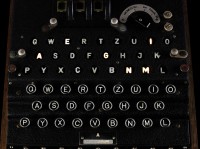 I was just talking about German Enigma encoding machines in the entry about the carrier pigeon, and now I stumble on an exceptionally beautiful one going up for auction at the Bonhams Scientific Instruments sale on November 14th. Sadly, I’m just short the estimated sale price of $64,000-$96,000, but I haven’t gone through my couch cushions yet so fingers crossed.
I was just talking about German Enigma encoding machines in the entry about the carrier pigeon, and now I stumble on an exceptionally beautiful one going up for auction at the Bonhams Scientific Instruments sale on November 14th. Sadly, I’m just short the estimated sale price of $64,000-$96,000, but I haven’t gone through my couch cushions yet so fingers crossed.
The Enigma enciphering machine was invented in 1918 by German engineer Arthur Scherbius. It’s an electrical Morse code-producing device that used a keyboard, lamps and a set of rotors to scramble text, then send it out to a receiving machine whose rotors were set in the exact same way as the originating machine’s. Enigma first went into production in the early 1920s and was used for civilian applications such as the protection of corporate trade secrets and private communications. The German Navy began to use it in 1926, but it was the German Army who in 1928 created a version distinctly different from the commercial machine. They added a plugboard which swapped pairs of letters and vastly increased the encipherment permutations.
 Presciently aware of the increasing likelihood of war when the Nazis became the majority party in German parliament in 1932, the Polish Cipher Bureau set to work on breaking Enigma. French Military Intelligence provided them with some important information that they had received from a German spy, most notably two sheets of Enigma daily key settings which laid out the calibration to decrypt messages for the day: the wheel order, rotor position, how the plugs should be connected to the plugboard, etc. Mathematician Marian Rejewski was then able to figure out how the military version of the Enigma encoder scrambled text. With this understanding of the logic of the mechanism, the Bureau was able to create replicas of Enigma machines that they could then use to intercept and decode German messages using daily keys which in early days came from spies and later were sorted out by permutation catalogs.
Presciently aware of the increasing likelihood of war when the Nazis became the majority party in German parliament in 1932, the Polish Cipher Bureau set to work on breaking Enigma. French Military Intelligence provided them with some important information that they had received from a German spy, most notably two sheets of Enigma daily key settings which laid out the calibration to decrypt messages for the day: the wheel order, rotor position, how the plugs should be connected to the plugboard, etc. Mathematician Marian Rejewski was then able to figure out how the military version of the Enigma encoder scrambled text. With this understanding of the logic of the mechanism, the Bureau was able to create replicas of Enigma machines that they could then use to intercept and decode German messages using daily keys which in early days came from spies and later were sorted out by permutation catalogs.
Germany kept adding layers of difficulty to the machines, and even though the Polish Cipher Bureau was incredibly successful in fighting back against each change, by late 1938 all the additional work of deciphering required to crack the code cost more than the Bureau had to spend. As war loomed ever closer in 1939, Poland decided to share their intelligence on the care and feeding of Enigma with France and Britain. In July of 1939, cryptologists from all three countries met outside of Warsaw and the Polish Cipher Bureau let the Allied experts in on everything they knew about breaking Enigma.
Gustave Bertrand, head of the cipher department of French Intelligence, was at the conference. With him was British Secret Agent Biffy Dunderdale whose mission, which he chose to accept, was to smuggle two Polish Engima replicas out of the country and to safety. He was successful, getting the machines first to Paris and then to London where the Bletchley Park codebreakers could now, just five weeks before the outbreak of war, pick up where the Polish Cipher Bureau had left off, which was as huge a morale boost as it was an information boost.
 Even though Germany added more rotors, more plugs, reflectors and other elements of difficulty as the war progressed, making decryption a consistently huge challenge, by 1945 the Allies were able to break Enigma codes in less than 24 hours. The Germans continued to use Enigma, not realizing that their coded messages were now crackable, or rather, not believing that the Allies would go to the immense trouble of, say, inventing Colossus computers that could calculate the daily key settings from trillions of possible combinations no matter how many rotors, plugs and variables Germany added.
Even though Germany added more rotors, more plugs, reflectors and other elements of difficulty as the war progressed, making decryption a consistently huge challenge, by 1945 the Allies were able to break Enigma codes in less than 24 hours. The Germans continued to use Enigma, not realizing that their coded messages were now crackable, or rather, not believing that the Allies would go to the immense trouble of, say, inventing Colossus computers that could calculate the daily key settings from trillions of possible combinations no matter how many rotors, plugs and variables Germany added.
Approximately 100,000 Engima machines were produced in Germany during the war. They were captured during Allied campaigns and occasionally taken as under-the-table souvenirs by troops. There are Enigma machines in museums and private collections around the world. The breaking of Enigma at Bletchley Park remained a government secret in Britain until 1974, after which the nerdy drama appeal of the story piqued interest in the machines. Nowadays when they come up for auction they’re expensive and highly desirable to collectors. Most of them have reproduction parts, though, or bits that were taken from one disabled machine to make another machine complete.
 The three-rotor 1941 model going on the auction block next week is entirely original and entirely intact. It is still in working condition with its original operating instructions affixed to the inside lid. There’s even a spare bulb rack complete with original bulbs, not to mention that it’s a damn good-looking piece of machinery with its striking white-on-black keyboard, ebonite-mounted plugboard and oak case with the remains of the factory wax seal and writing still visible on the lid.
The three-rotor 1941 model going on the auction block next week is entirely original and entirely intact. It is still in working condition with its original operating instructions affixed to the inside lid. There’s even a spare bulb rack complete with original bulbs, not to mention that it’s a damn good-looking piece of machinery with its striking white-on-black keyboard, ebonite-mounted plugboard and oak case with the remains of the factory wax seal and writing still visible on the lid.